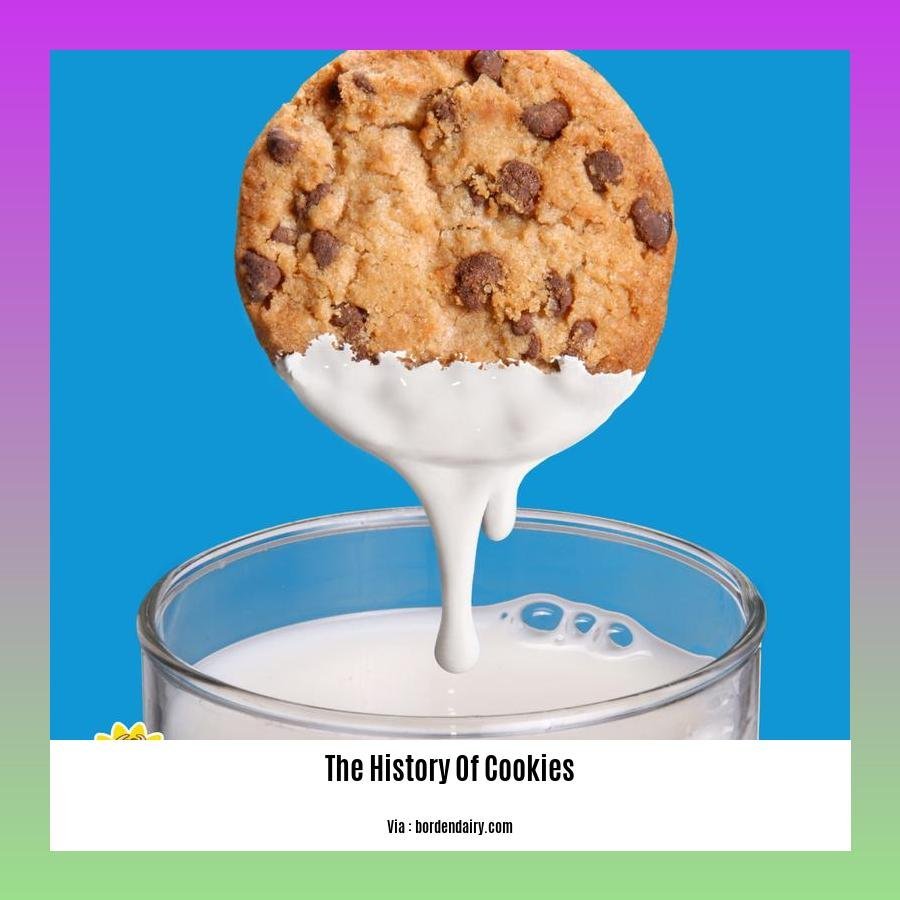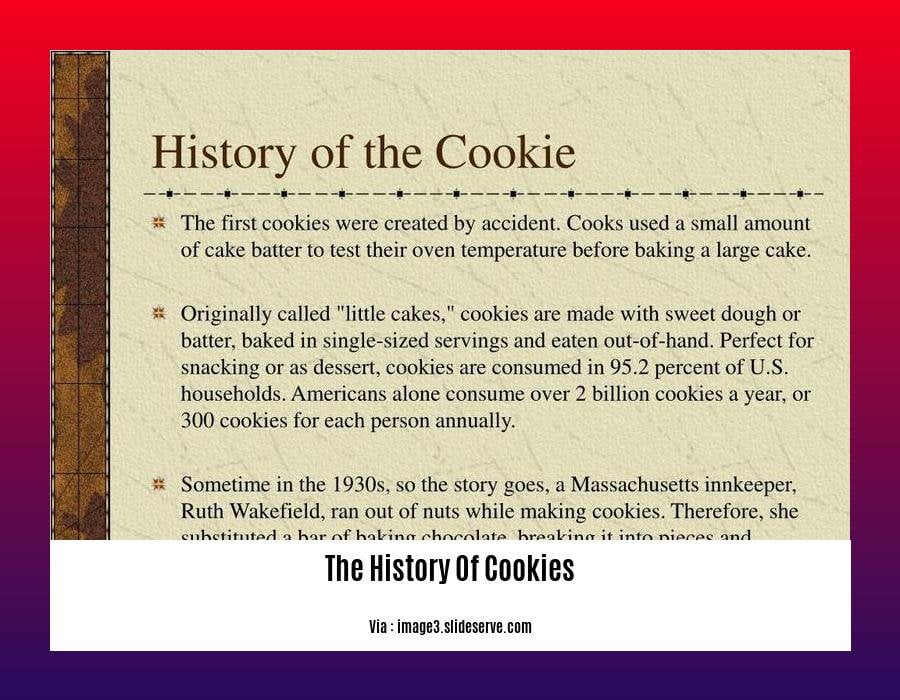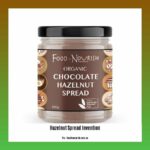Embark on a delectable voyage through the annals of time as we delve into the fascinating history of cookies in our article, “A Sweet Journey Through Time: Exploring the History of Cookies.” Join us as we uncover the origins of these beloved treats, trace their evolution across cultures, and discover the captivating stories behind their creation and spread. From humble beginnings to their current status as global culinary icons, cookies have played a significant role in shaping our culinary heritage. Prepare your taste buds for a journey that will leave you craving more.
Key Takeaways:
Cookies are flour-based sweet cakes.
They originated in Persia (now Iran) in the 7th century.
One of the first confectioneries to use sugar, which was being cultivated in the region.
By the end of the 14th century, cookies were common in Europe.
English, Scotch, and Dutch immigrants brought the first cookies to the United States.
The History of Cookies

In the realm of culinary delights, few treats hold as much universal appeal as the humble cookie. These bite-sized morsels, with their diverse flavors, textures, and shapes, have etched an indelible mark on culinary history, traversing continents and cultures for centuries. So, let’s embark on a delightful journey through time to explore the history of cookies.
Origins: A Sweet Treat Born in Persia
Our cookie odyssey begins in the 7th century in Persia, present-day Iran. These early confections, known as “kookjeh,” were crafted with simple ingredients like flour, sugar, and nuts. They were often flavored with spices such as cardamom, cinnamon, and saffron, reflecting the region’s rich culinary heritage.
Europe’s Embrace: Cookies Traverse Continents
By the 14th century, cookies had crossed the borders of Persia, finding a warm welcome in Europe. The expanding trade routes, particularly the Silk Road, played a pivotal role in this culinary exchange. European bakers experimented with local ingredients, creating regional variations of these delectable treats.
Colonial America: Cookies Arrive on New Shores
In the 17th century, English, Scotch, and Dutch immigrants brought their beloved cookie recipes to the shores of colonial America. These cookies, often made with hearty ingredients like molasses, ginger, and oats, quickly became a staple of American cuisine, symbolizing comfort, hospitality, and celebration.
The Rise of Mass Production: Cookies for the Masses
The advent of industrialization in the 19th century revolutionized cookie production. Mass-produced cookies, thanks to technological advancements like the rotary oven, became accessible to a broader audience. This led to the rise of iconic cookie brands, further solidifying the popularity of these delectable treats.
Cookies Today: A Global Phenomenon
Today, cookies are a ubiquitous presence across the globe. They come in countless varieties, reflecting the diverse cultural influences that have shaped our culinary landscape. From classic chocolate chip cookies to delicate macarons, these sweet treats continue to delight people of all ages, reminding us of the enduring power of simplicity and indulgence.
In conclusion, the history of cookies is a fascinating tapestry woven with stories of cultural exchange, culinary innovation, and the enduring love for these delightful treats. They have stood the test of time, adapting to evolving tastes and trends while retaining their universal appeal. So, next time you savor the sweet goodness of a cookie, take a moment to appreciate the rich history behind this humble yet beloved culinary creation.
Curious about the evolution of classical music? Delve into the history of classical music to uncover its fascinating journey through time.
Unravel the captivating narrative of science fiction’s origins and development in the history of science fiction.
Explore the intriguing journey of table tennis from its humble beginnings to its status as a global sport in the history of table tennis.
The Rise of Gingerbread: From Medicinal to Festive Delight

In the heart of medieval Germany, during the 13th century, a culinary creation emerged that would captivate taste buds and imaginations for centuries to come: gingerbread. This delectable treat, crafted from a harmonious blend of honey, aromatic spices, and flour, initially served a medicinal purpose. Its reputation as a healing confection, however, was soon eclipsed by its popularity at fairs and festivals, where it became a beloved symbol of joy and celebration.
Key Takeaways:
- Gingerbread originated in 13th-century Germany, where it was initially used for medicinal purposes.
- Its popularity soared at fairs and festivals, becoming a symbol of joy and celebration.
- Gingerbread houses, inspired by the Brothers Grimm’s fairy tale “Hansel and Gretel,” became a beloved tradition in Germany and later in North America.
- Queen Elizabeth I is credited with the idea of decorating gingerbread cookies to resemble visiting dignitaries.
A Culinary Journey Through Time
The origins of gingerbread can be traced back to the medieval apothecaries of Germany. Skilled healers, known as apothecaries, crafted gingerbread as a remedy for various ailments. Its aromatic spices, believed to possess medicinal properties, were thought to ward off illnesses and promote overall well-being.
As gingerbread’s popularity grew, it transcended its medicinal roots and became a staple at fairs and festivals throughout the region. Its enticing aroma and delicious taste captivated the hearts of all who savored it. Gingerbread bakers, known as Lebkuchenbäckers, honed their skills, creating intricate designs and elaborate shapes that delighted the eyes as much as the palate.
The Brothers Grimm’s fairy tale “Hansel and Gretel,” published in the 19th century, further immortalized gingerbread’s allure. Inspired by the tale’s enchanting gingerbread house, German bakers began crafting elaborate gingerbread houses, a tradition that would later cross the Atlantic and take root in North America.
Across the English Channel, Queen Elizabeth I, known for her love of lavish feasts, is credited with introducing the tradition of decorating gingerbread cookies. She commissioned gingerbread cookies adorned with intricate designs and likenesses of visiting dignitaries, elevating the confection to a symbol of royal hospitality and celebration.
Today, gingerbread stands as a beloved culinary tradition, enjoyed by people of all ages around the world. Its versatility has led to countless variations, from classic gingerbread cookies to intricate gingerbread houses, each reflecting the cultural heritage and creativity of its bakers.
Sources:
- The History and Origin of Gingerbread – The Spruce Eats
- Gingerbread History | The History Kitchen | PBS Food
The Cookie and the New World: European settlers brought their cookie-making traditions to the New World. In the 17th century, American colonists began experimenting with local ingredients like maple syrup and cranberries, creating unique cookie varieties.
These European settlers brought their cookie recipes and techniques across the Atlantic, laying the foundation for America’s rich cookie culture.
As American colonists settled into their new land, they adapted their European cookie traditions to the ingredients available to them. They experimented with local ingredients like maple syrup and cranberries, resulting in unique and delicious cookie varieties.
Maple syrup, a quintessential New World ingredient, added a unique sweetness and flavor to cookies. Cranberries, with their tart and tangy taste, provided a vibrant contrast to the sweetness of the cookies.
These ingenious adaptations gave birth to iconic American cookie varieties that continue to delight taste buds to this day. Maple cookies, with their golden-brown hue and maple-infused flavor, are a testament to the culinary creativity of the early colonists.
Cranberry cookies, bursting with the tangy goodness of cranberries, embody the fusion of European traditions with New World ingredients.
Key Takeaways:
- European settlers brought their cookie-making traditions to the Americas in the 17th century.
- American colonists experimented with local ingredients like maple syrup and cranberries, creating unique cookie varieties.
- Maple cookies and cranberry cookies are iconic examples of these New World cookie creations.
Sources:
- Salon.com: A Brief History of the Christmas Cookie
- Grabon Blog: The History of Cookies
Modern Cookie Evolution: The 19th century saw the invention of the ice cream cone. During World War I, cookies were sent to soldiers as a token of comfort from home. Today, cookies are produced industrially and enjoyed worldwide in countless variations.
The 19th Century: A Sweet Revolution
The 19th century ushered in a wave of innovations that transformed the way cookies were enjoyed. The invention of the ice cream cone at the 1904 World’s Fair in St. Louis, Missouri, marked a pivotal moment in cookie history. This delightful treat, a perfect fusion of cookie and ice cream, quickly captivated the world’s sweet tooth.
Cookies in Wartime: A Comforting Symbol
During World War I, cookies played a significant role in boosting the morale of soldiers fighting far from home. These small tokens of comfort, sent from loved ones back home, offered a taste of warmth and familiarity amidst the horrors of war. The simple act of receiving a homemade cookie served as a powerful reminder of the love and support that awaited them back home.
Industrialization: Cookies for the Masses
The advent of industrialization in the 19th century revolutionized cookie production, making these sweet treats more accessible than ever before. Mass production techniques allowed for the creation of vast quantities of cookies, ensuring that people from all walks of life could enjoy this delightful snack.
Global Delights: Cookies Across Cultures
Today, cookies have become an integral part of cultures worldwide, with countless variations reflecting diverse culinary traditions. From the delicate macarons of France to the hearty ANZAC biscuits of Australia and New Zealand, cookies have become a symbol of comfort, celebration, and cultural exchange.
Key Takeaways:
The invention of ice cream cones at the 1904 World’s Fair revolutionized cookie consumption.
Cookies provided comfort and connection for soldiers during World War I.
Industrialization in the 19th century transformed cookie production, making them accessible to the masses.
Today, cookies are cherished globally, with diverse variations reflecting cultural influences.
From ice cream cones to wartime comfort food, cookies have taken on many roles in the history of humanity.
Sources:
[History of the Ice Cream Cone:
[Cookies During World War I:
FAQ
Q1: When and where did cookies originate?
A1: Cookies originated in Persia (modern-day Iran) in the 7th century.
Q2: How did cookies spread across the world?
A2: Cookies spread throughout the Mediterranean region and Europe, thanks to wars and explorations, eventually becoming a popular treat worldwide.
Q3: What was the role of sugar in the history of cookies?
A3: Sugar was introduced to Persian baked goods, including cookies, thanks to the cultivation of sugarcane in Persia. This led to the creation of a sweeter and more flavorful cookie.
Q4: How did English, Scotch, and Dutch immigrants influence the history of cookies in the United States?
A4: English, Scotch, and Dutch immigrants brought their cookie-making traditions to the United States, contributing to the diversity and popularity of cookies in the country.
Q5: How did gingerbread originate and become associated with Christmas celebrations?
A5: Gingerbread originated in Germany during the 16th century and became a favorite treat at medieval European festivals and fairs. Gingerbread houses became popular after the Brothers Grimm published their fairy tale collection, which included “Hansel and Gretel.”















